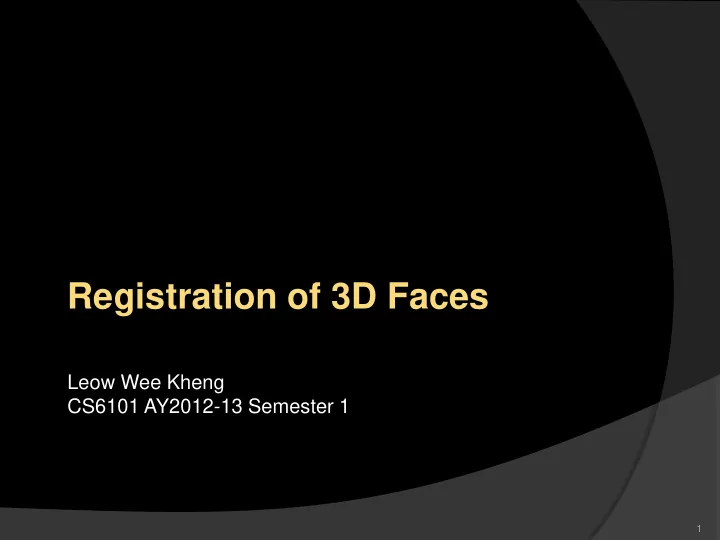

Registration of 3D Faces Leow Wee Kheng CS6101 AY2012-13 Semester 1 1
Main Paper T. J. Hutton, B. F. Buxton and P. Hammond. Automated Registration of 3D Faces using Dense Surface Models. In Proc. British Machine Vision Conference , 2003. 2
Motivation 3D face model useful for many applications: animation motion tracking face recognition face reconstruction surgery planning & simulation forensic reconstruction … 3
Motivation Build 3D face model from training samples: Need to align them: registration. 4
Motivation Can’t just align spatially: Everything is messed up! Need to align nose to nose, eyes to eyes, … 5
Motivation Two general kinds of registration: Rigid registration Objects differ by scale, rotation, translation. No change in shape during registration. Easy to solve. Non-rigid registration Objects differ by scale, rotation, translation, shape. Must change shape during registration. Harder to solve. 6
Motivation One possibility: manually mark landmark points. Very tedious and time-consuming! Need automatic method! 7
Focus 3D model has shape and texture. Focus on shape, leave out texture 8
Related Work ICP [Besl92, Feldmar96] Global alignment, not landmark correspondence. Mesh parameterisation [Brett97,98; Lorenz99,00; Praun01, Davies02] Re-mesh, rearrange mesh points consistently Their landmark = re-parameterised mesh points ≠ facial landmark. Shape features [Johnson99, Wang00, Yamany02, ] Surface curvature, geodesic distance, spin image; not landmark correspondence. 9
3D Face Registration Main ideas of Hutton et al.: Manually place 10 landmarks on training samples. Use landmark correspondence to compute mapping. Interpolate other points: thin-plate spline. ? 10
Mean Landmarks Compute mean landmarks of training samples. Procrustes alignment: Compute best alignment by similarity transformation, i.e., scaling, translation, rotation. Align landmarks of all training samples. Compute mean of landmarks. 11
Dense Correspondence Main steps: Warp mesh by thin-plate spline so that landmarks coincide with mean landmarks. 12
Dense Correspondence Resample warped mesh using reference mesh. Unwarp resampled mesh. Now, training samples have consistent mesh vertices. Some mesh vertices are facial landmarks. Now, can apply PCA on all mesh vertices. 13
Statistical face model Main steps: Align all resampled training samples. Perform PCA. Keep top principal components. Normally, shape parameters = + Φb x x Hutton et al. used unwhitening matrix = + ΦWb x x ( ) = λ λ 1 W diag , , k 14
Model Fitting no facial landmark Fit mean shape x to input shape y. Apply ICP to align x to y (align global pose). Repeat until convergence: ○ Map vertices on x to closest surface points on y. ○ New x 1 has similar shape as y. ○ Align x 1 to x giving x 2 . ○ Find shape parameters b of x 3 wrt face model: − = − Φ 1 T b W ( x x ) 2 ○ Restrict b to probable values b’ according to model. ○ Generate new shape x 3 with b’ from = + ΦWb x x ' close to y for generating y 3 15
Questions Can it work for skulls? How many skull landmarks? Strengths? Weaknesses? 16
Recommend
More recommend